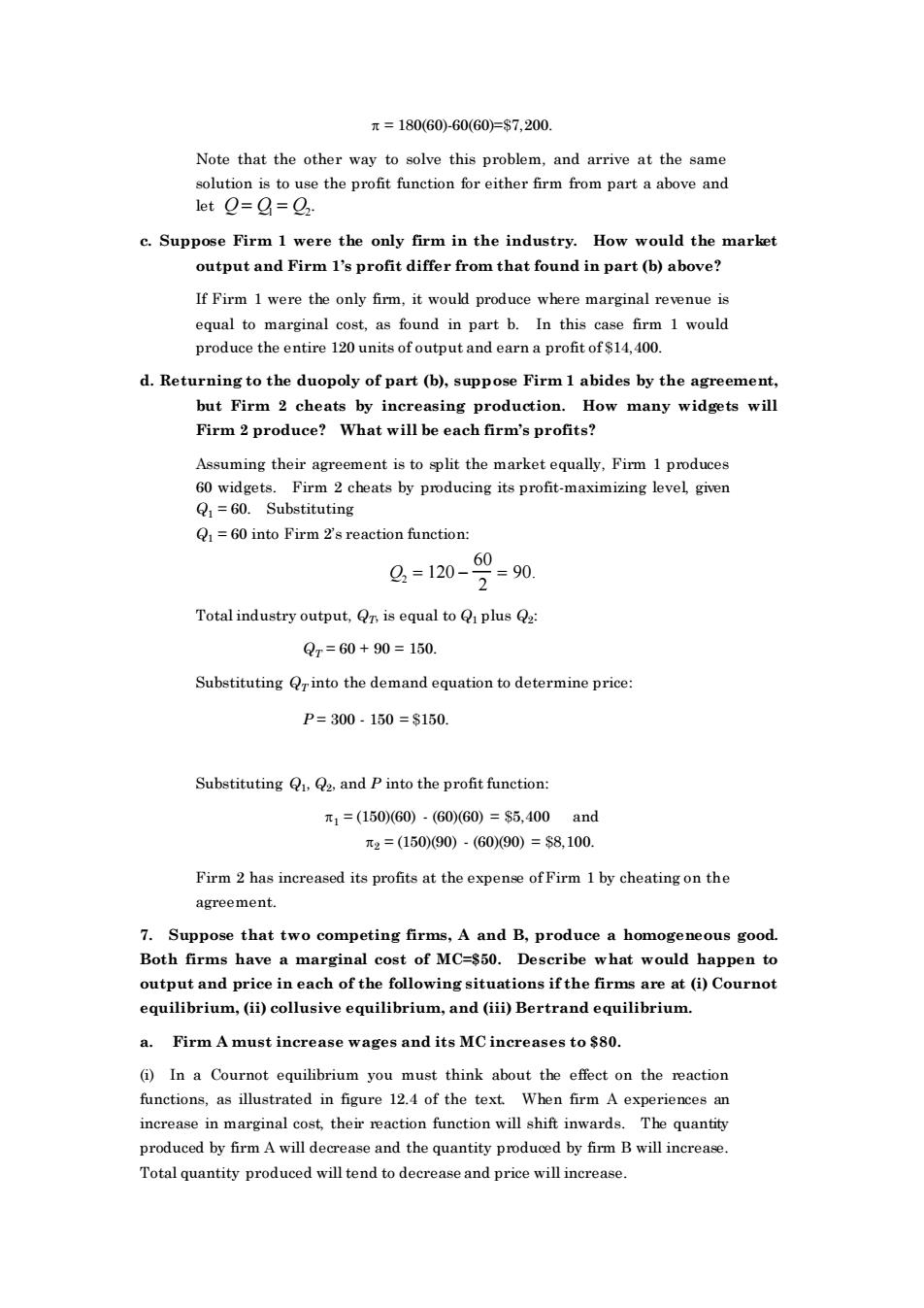正在加载图片...

元=180(60)-60(60)=$7,200. Note that the other way to solve this problem,and arrive at the same se the profit function for either firm from part a above an c.Suppose Firm 1 were the only firm in the industry.How would the market output and Firm I's profit differ from that found in part(b)above? If Firm 1 were the only firm.it would produce where marginal revenue is equal to marginal cost.as found in part b.In this case firm 1 would produce the entire 120 units of output and earn a profit of$14,400. d.Returningto the duopoly of part(b),suppose Firm 1 abides by the agreement but Firm 2 cheats by increasing production. How many widgets wil Firm 2 produce?What will be each firm's profits? Assuming their agreement is to split the market equally.Firm 1 produces 60 widgets.Firm 2 cheats by producing its profit-maximizing level given Q=60.Substituting Q=60 into Firm 2's reaction function: Q=120-9-90 Total industry output,is equal toplus Qr=60+90=150, Substituting into the demand equation to determine price P=300.150=$150 Substituting and Pinto the profit function: 元1=(15060)-(6060)=s5.400 and 2=(150)90)·(60)90)=$8,100. Firm 2 has increased its profits at the expense of Firm 1 by cheating on the agreement. geneous good. s have a marginal。 of MC=$50.De ibe what would happen to output and price in each of the following situations if the firms are at(i)Cournot equilibrium,(ii)collusive equilibrium,and(iii)Bertrand equilibrium. a.Firm A must increase wages and its MCincreases to $80. (i)In a Cournot equilibrium you must think about the effect on the reaction functions,as illustrated in figure 12.4 of the text.When firm A experiences an increase in marginal cost.their reaction function will shift inwards.The quantity = 180(60)-60(60)=$7,200. Note that the other way to solve this problem, and arrive at the same solution is to use the profit function for either firm from part a above and let Q= Q1 = Q2 . c. Suppose Firm 1 were the only firm in the industry. How would the market output and Firm 1’s profit differ from that found in part (b) above? If Firm 1 were the only firm, it would produce where marginal revenue is equal to marginal cost, as found in part b. In this case firm 1 would produce the entire 120 units of output and earn a profit of $14,400. d. Returning to the duopoly of part (b), suppose Firm 1 abides by the agreement, but Firm 2 cheats by increasing production. How many widgets will Firm 2 produce? What will be each firm’s profits? Assuming their agreement is to split the market equally, Firm 1 produces 60 widgets. Firm 2 cheats by producing its profit-maximizing level, given Q1 = 60. Substituting Q1 = 60 into Firm 2’s reaction function: Q2 = 120 − 60 2 = 90. Total industry output, QT, is equal to Q1 plus Q2 : QT = 60 + 90 = 150. Substituting QT into the demand equation to determine price: P = 300 - 150 = $150. Substituting Q1 , Q2 , and P into the profit function: 1 = (150)(60) - (60)(60) = $5,400 and 2 = (150)(90) - (60)(90) = $8,100. Firm 2 has increased its profits at the expense of Firm 1 by cheating on the agreement. 7. Suppose that two competing firms, A and B, produce a homogeneous good. Both firms have a marginal cost of MC=$50. Describe what would happen to output and price in each of the following situations if the firms are at (i) Cournot equilibrium, (ii) collusive equilibrium, and (iii) Bertrand equilibrium. a. Firm A must increase wages and its MC increases to $80. (i) In a Cournot equilibrium you must think about the effect on the reaction functions, as illustrated in figure 12.4 of the text. When firm A experiences an increase in marginal cost, their reaction function will shift inwards. The quantity produced by firm A will decrease and the quantity produced by firm B will increase. Total quantity produced will tend to decrease and price will increase